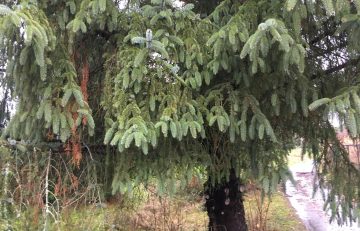
In temperate climates, all kinds of plants cease growth and lose their leaves as the light diminishes and temperatures fall. The ancients saw the loss of leaves and increasing darkness and cold with some trepidation. But evergreen plants—coniferous and broadleaf evergreens—are an antidote to the decay and gloominess of winter. Evergreen boughs were brought into dwellings to remind people that despite the conditions outside, plants were still alive. Evergreen foliage in a wreath or swag on the front door, or a Christmas tree inside, gradually came to represent the celebration of life, and hope for the future. With this in mind, and given the weather-related hardships of the last few winters, I hesitate to advertise the Garden’s floral charms in December. It could rain, snow or freeze with equal probability this month. I’m certain there will be at least a few flowers to see, but our native conifers form the foundation for much of the Garden and are seldom highlighted here.
A number of coniferous trees are native to the area of the Botanical Garden (i.e., found naturally locally). Western red cedar (Thuja plicata) and western hemlock (Tsuga heterophylla) are the most common. Because of their drooping evergreen foliage—an adaption to effectively shedding rain and snow—and tolerance of shade, they are iconic rainforest species. Beautiful as these two are as standing trees, they are also excellent cut greens. In fact, both are used extensively in the wreaths, swags and centrepieces made in a special workshop by the Friends of the Garden (FOGs). Visitors can find these arrangements available for sale in the Shop in the Garden (while quantities last) until December 22.
Pacific yew (Taxus brevifolia) also inhabits shadier corners of the native forest, but they are few in number and slow to increase in size, which does not allow for significant harvesting. Although the trees themselves are less obviously attractive than most of our other conifers (most look like they’ve had a piano dropped on them), their dark green needle-clothed branches would be attractive in any arrangement. The bark on older stems is often exquisite, as well. In general, though, it’s the more common, exotic yew species that have to stand in. Two other native species, Sitka spruce (Picea sitchensis) and shore pine (Pinus contorta var. contorta) are found in open, sometimes boggy areas of the coastal forest. The pine, with its short needles and flexible stems is readily incorporated into wreaths and such, but the spruce, because of its stiff, prickly needles, is particularly difficult to work with. Occasionally, a brave FOG will incorporate Sitka spruce or a branch from another spruce into an arrangement. We have four Picea species native to BC, but only the Sitka is local to UBC. Pines, too, are familiar BC natives (there are five), but only shore pine is common at the coast.
On the other hand, grand fir (Abies grandis) is a surprisingly common constituent of the Asian Garden forest, and an ideal Christmas tree and holiday foliage subject. The strong grapefruit-peel aroma of its glossy, flattened, easily-handled needles sets it apart from other trees. Another two other native firs and a native hemlock can’t really be considered locally native, as they are only found growing wild in the nearby mountains. Mountain hemlock (Tsuga mertensiana) would be a perfect candidate for wreath-making were it a more common tree across the UBC campus (where we harvest about one half of the greens for wreath making). Subalpine fir (Abies lasiocarpa) and Pacific silver fir (Abies amabilis) could also provide appropriate material if they were more widely grown. All three would make perfect Christmas trees, as they naturally produce trees that are desirously densely conical. Aromatically, the needles of subalpine fir smell of balsam (with a touch of oregano) and those of Pacific silver fir have a remarkable tangerine fragrance.
Many people can recognize a Douglas fir (Pseudotsuga menziesii). It is the most popular species in North America for cut Christmas trees. It is loved for its soft, sweet-smelling needles, strong, flexible branches and natural youthful symmetry. In nature, trees can grow to a staggering 100 m or more in height. This is what the first Europeans would have seen as they sailed around Point Grey and into Burrard Inlet. Discovering that the timber was of exceptional quality, it’s no surprise that the entire Vancouver area was essentially clear-cut before the 1920s. Only two Douglas firs in the Botanical Garden (both in the Asian Garden) survived the harvest. They are giant snags, both estimated to be over 400 years old; riddled with dead wood, they were too dangerous to cut down. When that old, Douglas firs don’t look much like Christmas trees, but are the favoured high perches for bald eagles, whose increasing presence—as much as the dropping of deciduous leaves in autumn—signifies the onset of winter at the Botanical Garden.
- Abies amabilis
- Abies grandis
- Picea sitchensis
- Pinus contorta var contorta
- Pseudotsuga menziesii
- Taxus brevifolia
- Thuja plicata
- Tsuga heterophylla
- Pseudotsuga menziesii
- Tsuga mertensiana
- Abies grandis
- Abies lasiocarpa
Submitted by: Douglas Justice, Associate Director, Horticulture and Collections












